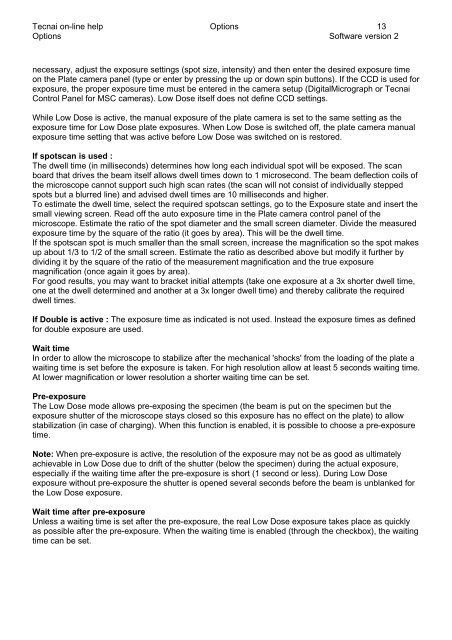Tecnai on-line help manual -- Options - UT Southwestern
Tecnai on-line help manual -- Options - UT Southwestern
Tecnai on-line help manual -- Options - UT Southwestern
- No tags were found...
You also want an ePaper? Increase the reach of your titles
YUMPU automatically turns print PDFs into web optimized ePapers that Google loves.
<str<strong>on</strong>g>Tecnai</str<strong>on</strong>g> <strong>on</strong>-<strong>line</strong> <strong>help</strong> Opti<strong>on</strong>s 13Opti<strong>on</strong>s Software versi<strong>on</strong> 2necessary, adjust the exposure settings (spot size, intensity) and then enter the desired exposure time<strong>on</strong> the Plate camera panel (type or enter by pressing the up or down spin butt<strong>on</strong>s). If the CCD is used forexposure, the proper exposure time must be entered in the camera setup (DigitalMicrograph or <str<strong>on</strong>g>Tecnai</str<strong>on</strong>g>C<strong>on</strong>trol Panel for MSC cameras). Low Dose itself does not define CCD settings.While Low Dose is active, the <strong>manual</strong> exposure of the plate camera is set to the same setting as theexposure time for Low Dose plate exposures. When Low Dose is switched off, the plate camera <strong>manual</strong>exposure time setting that was active before Low Dose was switched <strong>on</strong> is restored.If spotscan is used :The dwell time (in millisec<strong>on</strong>ds) determines how l<strong>on</strong>g each individual spot will be exposed. The scanboard that drives the beam itself allows dwell times down to 1 microsec<strong>on</strong>d. The beam deflecti<strong>on</strong> coils ofthe microscope cannot support such high scan rates (the scan will not c<strong>on</strong>sist of individually steppedspots but a blurred <strong>line</strong>) and advised dwell times are 10 millisec<strong>on</strong>ds and higher.To estimate the dwell time, select the required spotscan settings, go to the Exposure state and insert thesmall viewing screen. Read off the auto exposure time in the Plate camera c<strong>on</strong>trol panel of themicroscope. Estimate the ratio of the spot diameter and the small screen diameter. Divide the measuredexposure time by the square of the ratio (it goes by area). This will be the dwell time.If the spotscan spot is much smaller than the small screen, increase the magnificati<strong>on</strong> so the spot makesup about 1/3 to 1/2 of the small screen. Estimate the ratio as described above but modify it further bydividing it by the square of the ratio of the measurement magnificati<strong>on</strong> and the true exposuremagnificati<strong>on</strong> (<strong>on</strong>ce again it goes by area).For good results, you may want to bracket initial attempts (take <strong>on</strong>e exposure at a 3x shorter dwell time,<strong>on</strong>e at the dwell determined and another at a 3x l<strong>on</strong>ger dwell time) and thereby calibrate the requireddwell times.If Double is active : The exposure time as indicated is not used. Instead the exposure times as definedfor double exposure are used.Wait timeIn order to allow the microscope to stabilize after the mechanical 'shocks' from the loading of the plate awaiting time is set before the exposure is taken. For high resoluti<strong>on</strong> allow at least 5 sec<strong>on</strong>ds waiting time.At lower magnificati<strong>on</strong> or lower resoluti<strong>on</strong> a shorter waiting time can be set.Pre-exposureThe Low Dose mode allows pre-exposing the specimen (the beam is put <strong>on</strong> the specimen but theexposure shutter of the microscope stays closed so this exposure has no effect <strong>on</strong> the plate) to allowstabilizati<strong>on</strong> (in case of charging). When this functi<strong>on</strong> is enabled, it is possible to choose a pre-exposuretime.Note: When pre-exposure is active, the resoluti<strong>on</strong> of the exposure may not be as good as ultimatelyachievable in Low Dose due to drift of the shutter (below the specimen) during the actual exposure,especially if the waiting time after the pre-exposure is short (1 sec<strong>on</strong>d or less). During Low Doseexposure without pre-exposure the shutter is opened several sec<strong>on</strong>ds before the beam is unblanked forthe Low Dose exposure.Wait time after pre-exposureUnless a waiting time is set after the pre-exposure, the real Low Dose exposure takes place as quicklyas possible after the pre-exposure. When the waiting time is enabled (through the checkbox), the waitingtime can be set.
















